High-Order Domain-Wall Dark Harmonic Pulses and Their Transition to H-Shaped and DSR Pulses in a Dumbbell-Shaped Fiber Laser at 1563 nm
Abstract
1. Introduction
2. Experimental Setup
3. Results and Discussions
3.1. High-Order Harmonic Domain-Wall Dark Pulses
3.2. DSR Pulses
3.3. Dual Wavelength H-Shaped Pulses
4. Conclusions
Author Contributions
Funding
Data Availability Statement
Conflicts of Interest
References
- Bekki, N.; Nozaki, K. Formations of spatial patterns and holes in the generalized Ginzburg-Landau equation. Phys. Lett. A 1985, 110, 133–135. [Google Scholar] [CrossRef]
- Serkin, N.; Hasegawa, B.A. Novel soliton solutions of the nonlinear Schrödinger equation model. Phys. Rev. Lett. 2000, 85, 4502–4505. [Google Scholar] [CrossRef]
- Kuzin, E.A.; Ibarra-Escamilla, B.; Garcia-Gomez, D.E.; Haus, J.W. Fiber laser mode locked by a Sagnac interferometer with nonlinear polarization rotation. Opt. Lett. 2001, 26, 1559–1561. [Google Scholar] [CrossRef] [PubMed]
- Afanajev, V.V.; Dianov, E.M.; Serkin, N. Nonlinear pairing of short bright and dark soliton pulses by phase cross modulation. IEEE J. Quantum Electron. 1989, 25, 2656–2664. [Google Scholar] [CrossRef]
- Tiu, Z.C.; Harun, S.W.; Ahmad, H.; Samion, M.Z.; Tan, S.J. Dark pulse generation in fiber laser system. Opt. Laser Technol. 2022, 151, 108056. [Google Scholar] [CrossRef]
- Lin, R.; Wang, Y.; Yan, P.; Zhang, G.; Zhao, J.; Li, H.; Huang, S.; Cao, G.; Duan, J. Bright and dark square pulses generated from a graphene-oxide mode-locked ytterbium-doped fiber laser. IEEE Photonics J. 2014, 6, 1500908. [Google Scholar] [CrossRef]
- Zhang, W.; Zhan, L.; Xian, T.; Gao, L. Generation of bright/dark pulses in an erbium-doped fiber laser mode-locked with glycerin. Light. Technol. 2019, 37, 3756–3760. [Google Scholar] [CrossRef]
- Wang, G.; Sheng, Q.; Tang, S.; Li, Q.; Xiong, S.; Lu, C.; Bai, C.; Zhang, W.; Zhang, H.; Fu, S. Evolution between bright and dark pulses in a MoxW1-xTe2 based fiber laser. Opt. Express 2023, 31, 26145–26155. [Google Scholar] [CrossRef]
- Zhang, H.; Tang, D.; Zhao, L.; Knize, R. Vector dark domain wall solitons in a fiber ring laser. Opt. Express 2010, 18, 4428–4434. [Google Scholar] [CrossRef]
- Xue, X.; Xuan, Y.; Liu, Y.; Wang, P.; Chen, S.; Wang, J.; Leaird, D.; Qi, M.; Weiner, A. Mode-locked dark pulse Kerr combs in normal-dispersion microresonators. Nat. Photonics 2015, 9, 594–600. [Google Scholar] [CrossRef]
- Wang, L.; Xu, W.; Luo, Z.; Cao, W.; Luo, A.; Dong, J.; Wang, H. Dark pulses with tunable repetition rate emission from fiber ring laser. Opt. Commun. 2012, 285, 2113–2117. [Google Scholar] [CrossRef]
- Tiu, Z.C.; Suthaskumar, M.; Zarei, A.; Tan, S.; Ahmad, H.; Harun, S.W. Generation of switchable domain wall and cubic–quintic nonlinear Schr¨odinger equation dark pulse. Opt. Laser Technol. 2015, 73, 127–129. [Google Scholar] [CrossRef]
- Paul, N.; Singh, C.; Gupta, P.; Bhuvnesh; Mukhopadhyay, P.; Bindra, K. Rectangular dark pulses in all-normal dispersion fiber oscillator. Opt. Laser Technol. 2022, 147, 107641. [Google Scholar] [CrossRef]
- Liu, J.; Li, X.; Zhang, S.; Zhang, H.; Yan, P.; Han, M.; Pang, Z.; Yang, Z. Polarization domain wall pulses in a microfiber-based topological insulator fiber laser. Sci. Rep. 2016, 6, 29128. [Google Scholar] [CrossRef] [PubMed]
- Haelterman, M.; Sheppard, A. Polarization domain walls in diffractive or dispersive Kerr media. Opt. Lett. 1994, 19, 96–98. [Google Scholar] [CrossRef]
- Zhang, H.; Tang, D.; Zhao, L.; Wu, X. Dual-wavelength domain wall solitons in a fiber ring laser. Opt. Express 2011, 19, 3525–3530. [Google Scholar] [CrossRef]
- Wang, P.; Zhao, K.; Xiao, X.; Yang, C. Pulse dynamics of dual-wavelength dissipative soliton resonances and domain wall solitons in a Tm fiber laser with fiber-based Lyot filter. Opt. Express 2017, 25, 30708–30719. [Google Scholar] [CrossRef] [PubMed]
- Chen, Y.; Cheak, T.Z.; Jin, T.S.; Vinitha, G.; Dimyati, K.; Harun, S.W. Domain-wall dark pulse generation with SMF-GIMF-SMF structure as artificial saturable absorber. Sci. Rep. 2024, 14, 2141. [Google Scholar] [CrossRef]
- Zhang, W.; Zhan, L.; Xian, T.; Gao, L. Bidirectional dark soliton mode-locked fiber laser based on thulium-doped fiber saturable absorber. In Proceedings of the Laser Science and Technology 2019, Wuhan, China, 11–14 November 2019. Paper LTh4C.3. [Google Scholar] [CrossRef]
- Gao, W.; Liao, M.; Kawashima, H.; Suzuki, T.; Ohishi, Y. Dark-square-pulse generation in a ring cavity with a tellurite single-mode fiber. IEEE Photonics Technol. Lett. 2013, 25, 546–549. [Google Scholar] [CrossRef]
- Liu, J.; Zhao, F.; Wang, H.; Zhang, W.; Hu, X.; Li, X.; Wang, Y. Generation of dark solitons in erbium-doped fiber laser based on black phosphorus nanoparticles. Opt. Mater. 2019, 89, 100–105. [Google Scholar] [CrossRef]
- Koo, J.; Ashok, N.; Kim, D.H.; Shin, W. Bi2Te3 topological insulator for domain-wall dark pulse generation from thulium-doped fiber laser. Crystals 2019, 9, 337. [Google Scholar] [CrossRef]
- Ahmad, H.; Tiu, Z.C.; Zarei, A.; Suthaskumar, M.; Salim, M.A.M.; Harun, S.W. Domain-wall dark pulse generation in fiber laser incorporating MoS2. Appl. Phys. B 2016, 122, 69. [Google Scholar] [CrossRef]
- Liu, H.; Chow, K. Dark pulse generation in fiber lasers incorporating carbon nanotubes. Opt. Express 2014, 22, 29708–29713. [Google Scholar] [CrossRef] [PubMed]
- Zhang, W.; Zhan, L.; Xian, T.; Gao, L. Harmonic mode-locking in bidirectional domain-wall soliton fiber lasers. J. Light. Technol. 2019, 37, 5417–5421. [Google Scholar] [CrossRef]
- Chi, M.; Tiu, Z.C.; Fu, H.; Li, Q.; Harun, S.W. Harmonic domain-wall dark pulse generation using unpumped thin-core thulium fiber as interferometer. Opt. Laser Technol. 2024, 177, 111045. [Google Scholar] [CrossRef]
- Zhou, R.; Yu, D.; Liu, X.; Li, Q.; Fu, H.Y. Dark rectangular noise-like pulses in a figure-nine fiber laser based on a nonlinear amplifying loop mirror. Opt. Lett. 2019, 44, 3717–3720. [Google Scholar] [CrossRef]
- Wu, X.; Tang, D.Y.; Zhang, H.; Zhao, L.M. Dissipative soliton resonance in an all-normal-dispersion erbium-doped fiber laser. Opt. Express 2009, 17, 5580–5584. [Google Scholar] [CrossRef]
- Wang, S.K.; Ning, Q.Y.; Luo, A.P.; Lin, Z.B.; Luo, Z.C.; Xu, W.C. Dissipative soliton resonance in a passively mode-locked figure-eight fiber laser. Opt. Express 2013, 21, 2402–2407. [Google Scholar] [CrossRef]
- Luo, Z.C.; Ning, Q.Y.; Mo, H.L.; Cui, H.; Liu, J.; Wu, L.J.; Luo, A.P.; Xu, W.C. Vector dissipative soliton resonance in a fiber laser. Opt. Express 2013, 21, 10199–10204. [Google Scholar] [CrossRef]
- Liu, L.; Liao, J.H.; Ning, Q.Y.; Yu, W.; Luo, A.P.; Xu, S.H.; Luo, Z.C.; Yang, Z.M.; Xu, W.C. Wave-breaking-free pulse in an all-fiber normal-dispersion Yb-doped fiber laser under dissipative soliton resonance condition. Opt. Express 2013, 21, 27087–27092. [Google Scholar] [CrossRef]
- Lin, H.; Guo, C.; Ruan, S.; Yang, J. Dissipative soliton resonance in an all-normal-dispersion Yb-doped figure-eight fibre laser with tunable output. Laser Phys. Lett. 2014, 11, 085102. [Google Scholar] [CrossRef]
- Krzempek, K. Dissipative soliton resonances in all-fiber Er-Yb double clad figure-8 laser. Opt. Express 2015, 23, 30651–30656. [Google Scholar] [CrossRef]
- Cao, Y.; Jia, D.; Liu, T.; Yang, T.; Wang, Z.; Ge, C. Generation of a square pulse with ultra-wide tuning range in a passively mode-locked Yb-doped fiber laser. Appl. Opt. 2017, 56, 6742–6747. [Google Scholar] [CrossRef]
- Lyu, Y.; Shi, H.; Wei, C.; Li, H.; Li, J.; Liu, Y. Harmonic dissipative soliton resonance pulses in a fiber ring laser at different values of anomalous dispersion. Photon. Res. 2017, 5, 612–616. [Google Scholar] [CrossRef]
- Chowdhury, S.D.; Pal, A.; Chatterjee, S.; Sen, R.; Pal, M. Multipulse dynamics of dissipative soliton resonance in an all-normal dispersion mode-locked fiber laser. J. Light. Technol. 2018, 36, 5773–5779. [Google Scholar] [CrossRef]
- Ahmad, H.; Aidit, S.N.; Tiu, Z.C. Dissipative soliton resonance in a passively mode-locked praseodymium fiber laser. Opt. Laser Technol. 2019, 112, 20–25. [Google Scholar] [CrossRef]
- Li, Z.; Jia, D.; Sun, X.; Yuan, Q.; Cao, X.; Zhang, P. Multiple stable states of dissipative soliton resonance in a passively mode-locked Yb-doped fiber laser. Appl. Opt. 2019, 58, 6841–6847. [Google Scholar] [CrossRef]
- Du, W.; Li, H.; Li, J.; Wang, Z.; Wang, P.; Zhang, Z.; Liu, Y. Polarization dynamics of dissipative-soliton-resonance pulses in passively mode-locked fiber lasers. Opt. Express 2019, 27, 8059–8068. [Google Scholar] [CrossRef] [PubMed]
- Lyu, Y.; Chen, W.; Du, W.; Li, H.; Liu, Y. Splitting and motions of dissipative soliton resonance pulses in mode-locked fiber lasers. Front. Phys. 2019, 7, 173. [Google Scholar] [CrossRef]
- Ma, X.; Feng, T.; Zhao, S.; Liu, Y.; Wang, C.; Shang, J.; Hu, P.; Mao, J.; Yang, K.; Li, T. Dissipative soliton resonance and noise-like pulse in a self-pulsing fiber laser. Opt. Laser Technol. 2023, 157, 108754. [Google Scholar] [CrossRef]
- Zhao, B.; Zhao, T.X.; Liu, G.X.; Zhao, N.; Cui, H.; Luo, Z.C.; Xu, W.C.; Luo, A.P. Dissipative soliton resonance in a figure-eight multimode fiber laser. Opt. Express 2023, 31, 17354–17363. [Google Scholar] [CrossRef] [PubMed]
- Yang, F.; Gu, Q.; Lin, Y.; Wang, M.; Liu, M.; Ouyang, D.; Wu, X.; Zhao, J.; Guo, C.; Lue, Q.; et al. 5.4 W, 2.35 µm cascaded Raman fiber laser pumped by dissipative soliton resonance-like pulses. Opt. Express 2024, 32, 18539–18549. [Google Scholar] [CrossRef] [PubMed]
- Wang, Z.; Wang, M.; Huang, X.; Gu, R.; Li, J.; Li, H.; Liu, Y. Efficient tunable cascaded Raman source with all-silica fibers based on 2-µm DSR pulse pumping. Opt. Express 2024, 32, 12992–13000. [Google Scholar] [CrossRef]
- Michalska, M.; Klein, M.; Dlubek, M. Dissipative soliton resonance in a normal dispersion all-polarization-maintaining thulium-doped fiber laser. Opt. Laser Technol. 2025, 181, 111895. [Google Scholar] [CrossRef]
- He, X.; Fang, X.; Liao, C.; Wang, D.N.; Sun, J. A tunable and switchable single-longitudinal-mode dual-wavelength fiber laser with a simple linear cavity. Opt. Express 2009, 17, 21773–21781. [Google Scholar] [CrossRef] [PubMed]
- Ahmad, H.; Soltanian, R.; Pua, S.; Zulkifli, M.Z.; Harun, S.W. Narrow Spacing Dual-Wavelength Fiber Laser Based on Polarization Dependent Loss Control. Photonics J. 2013, 5, 1502706. [Google Scholar] [CrossRef]
- Paul, N.; Bhuvnesh, B.; Singh, C.P.; Gupta, P.K.; Mukhopadhyay, P.K.; Bindra, K.S. Dual-wavelength rectangular pulses in a mode-locked ytterbium-doped fiber laser. Laser Phys. 2020, 30, 075103. [Google Scholar] [CrossRef]
- Wang, S.; Zhang, M.; Wang, H.; Hu, G. Single- and dual-wavelength fiber laser with multi-transverse modes. Opt. Express 2021, 29, 20299–20306. [Google Scholar] [CrossRef]
- Luo, X.; Tuan, T.H.; Saini, T.S.; Nguyen, H.P.T.; Suzuki, T.; Ohishi, Y. Switchable dual-wavelength mode-locked fiber laser using Saganc loop mirror. Opt. Commun. 2020, 463, 125457. [Google Scholar] [CrossRef]
- Zhao, J.; Li, L.; Zhao, L.; Tang, D.; Shen, D. Cavity-birefringence-dependent h-shaped pulse generation in a thulium-holmium-doped fiber laser. Opt. Lett. 2018, 43, 247–250. [Google Scholar] [CrossRef]
- Zheng, Z.; Ren, X.; Zhu, K.; Ouyang, D.; Wang, J.; Guo, C.; Du, G.; Pei, J.; Lue, Q.; Ruan, S. Fundamental and harmonic mode-locked h-shaped pulse generation using a figure-of-9 thulium-doped fiber laser. Opt. Express 2019, 27, 37172–37179. [Google Scholar] [CrossRef] [PubMed]
- He, Z.; Chen, Y.; Deng, Z.; Fang, Z.; Liu, J.; Fan, D. H-shaped pulse generation with tunable leading edge from a Tm-doped mode-locked fiber laser. Appl. Phys. Express 2020, 13, 012011. [Google Scholar] [CrossRef]
- Zhao, J.; Zhou, J.; Li, L.; Klimczak, M.; Komarov, A.; Su, L.; Tang, D.; Shen, D.; Zhao, L. Narrow-bandwidth h-shaped pulse generation and evolution in a net normal dispersion thulium-doped fiber laser. Opt. Express 2019, 27, 29770–29780. [Google Scholar] [CrossRef]
- Zhao, J.; Li, L.; Zhao, L.; Tang, D.; Shen, D.; Su, L. Tunable and switchable harmonic h-shaped pulse generation in a 3.03 km ultralong mode-locked thulium-doped fiber laser. Photon. Res. 2019, 7, 332–340. [Google Scholar] [CrossRef]
- Zhao, J.; Zhou, J.; Jiang, Y.; Li, L.; Shen, D.; Komarov, A.; Su, L.; Tang, D.; Klimczak, M.; Zhao, L. Nonlinear Absorbing-Loop Mirror in a Holmium-Doped Fiber Laser. J. Light. Technol. 2020, 38, 6069–6075. [Google Scholar] [CrossRef]
- He, Y.; Li, M.; Shu, Y.; Ning, Q.; Chen, W.; Luo, A. Generation of H-shaped pulse rains induced by intracavity Fabry–Perót filtering in a fiber laser. Opt. Fiber Technol. 2021, 61, 102453. [Google Scholar] [CrossRef]
- Liu, C.; Li, G.; Su, X.; Wang, Y.; Gao, F.; Xie, Y.; Kumar, S.; Zhang, B. Generation of h-shaped pulse in a mode-locked erbium-doped fiber laser. Front. Phys. 2022, 10, 2296. [Google Scholar] [CrossRef]
- Gu, L.; Liu, Z.; Shu, Y.; Cui, Z.; Zhou, K.; Li, J.; Luo, A.; Chen, W. Artificial manipulation of h-shaped pulse generation by synthetizing composite filtering effects. Opt. Laser Technol. 2023, 157, 108659. [Google Scholar] [CrossRef]
- Zhao, Y.; Gao, B.; Di, H.; Huo, J.; Zhou, L.; Han, Y.; Wu, G.; Liu, L. Wavelength tunable noise-like pulses in a hybrid mode-locked erbium-doped fiber laser. Opt. Fiber Technol. 2024, 87, 103893. [Google Scholar] [CrossRef]
- Chang, W.; Ankiewicz, A.; Soto-Crespo, J.M.; Akhmediev, N. Dissipative soliton resonances. Phys. Rev. A 2008, 78, 023830. [Google Scholar] [CrossRef]
- Yang, Y.; Wang, C.; Han, M.; Li, X.; Li, H.; Liu, J.; Zhang, S. Wavelength Convertible Flat/Tilt-Top Dissipative-Soliton-Resonance Pulses in an Anomalous Dispersion Fiber Laser. J. Light. Technol. 2024, 42, 6925–6931. [Google Scholar] [CrossRef]
- Zhao, K.; Wang, P.; Ding, Y.; Yao, S.; Gui, L.; Xiao, X.; Yang, C. High-energy dissipative soliton resonance and rectangular noise-like pulse in a figure-9 Tm fiber laser. Appl. Phys. Express 2019, 12, 012002. [Google Scholar] [CrossRef]
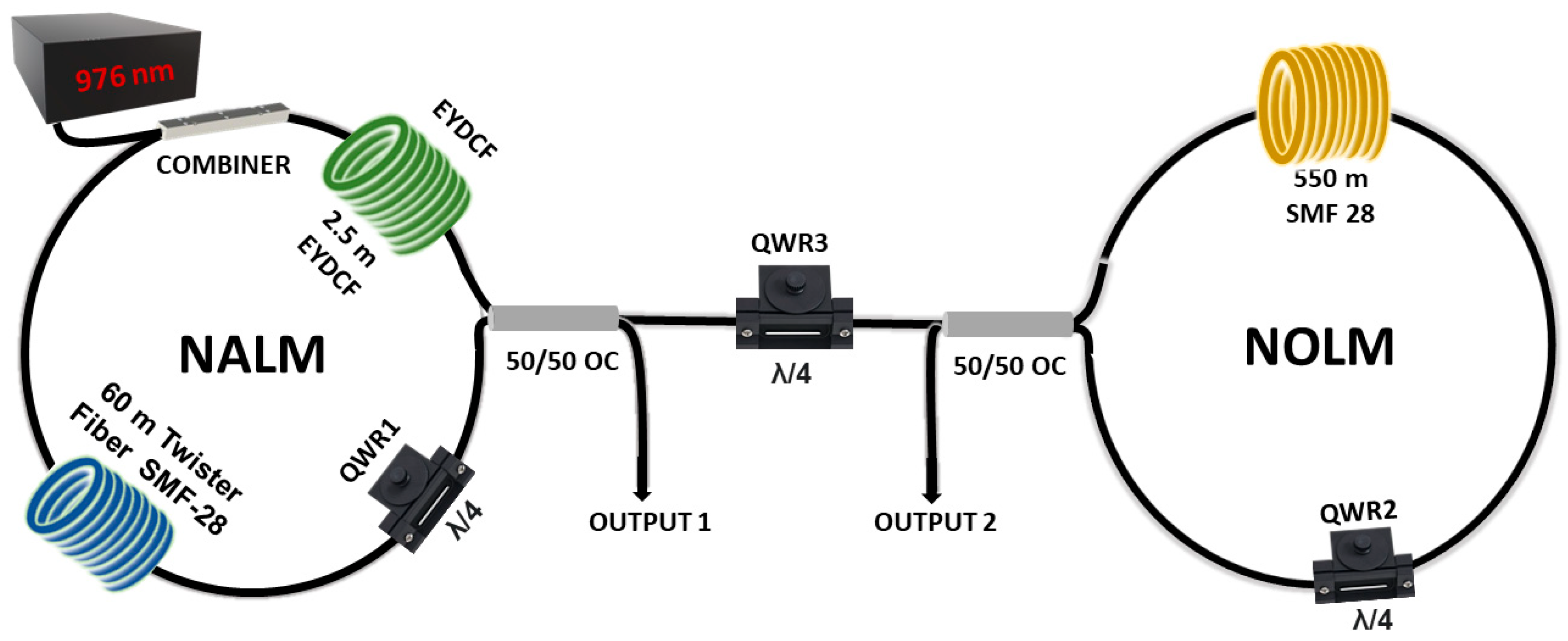
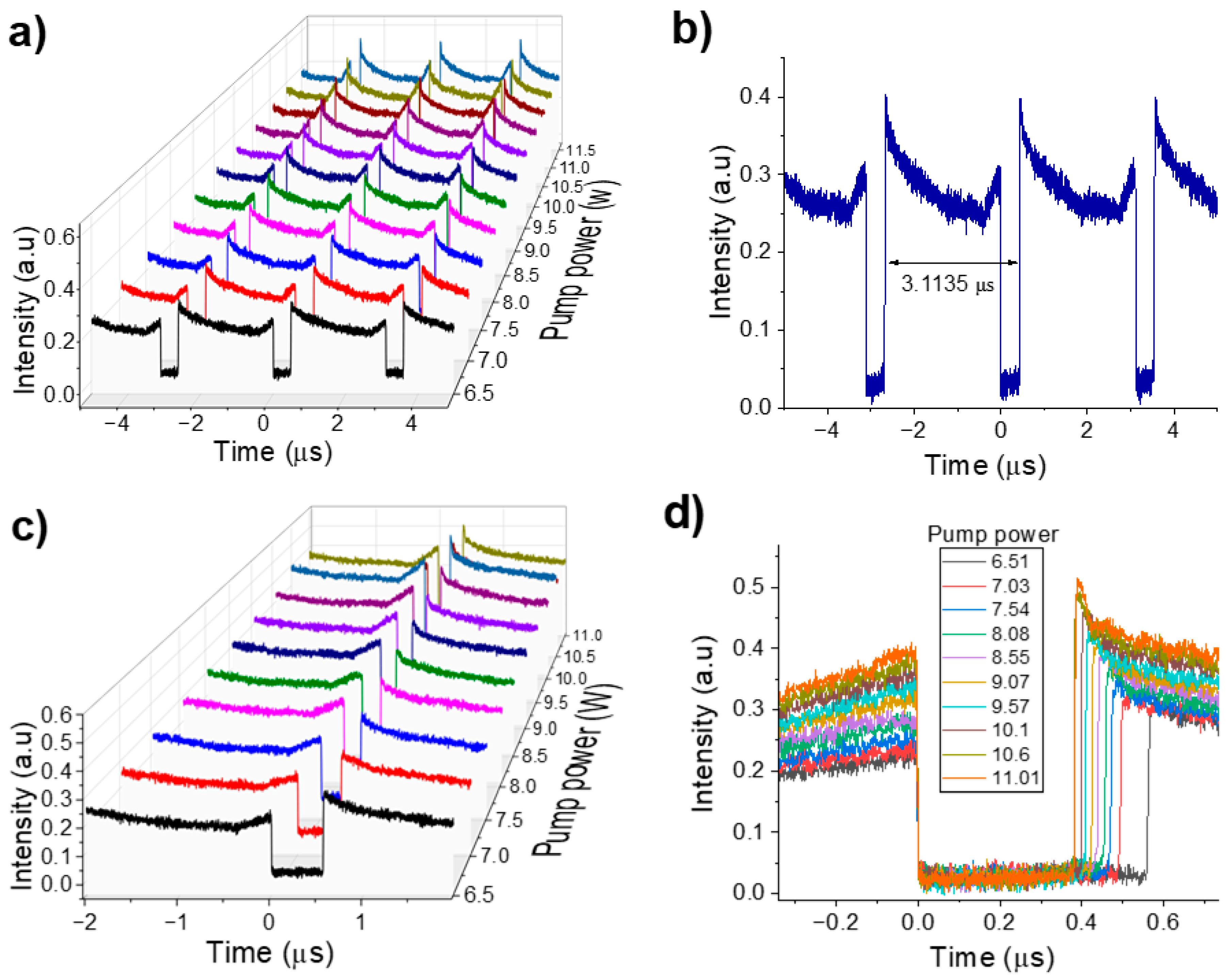

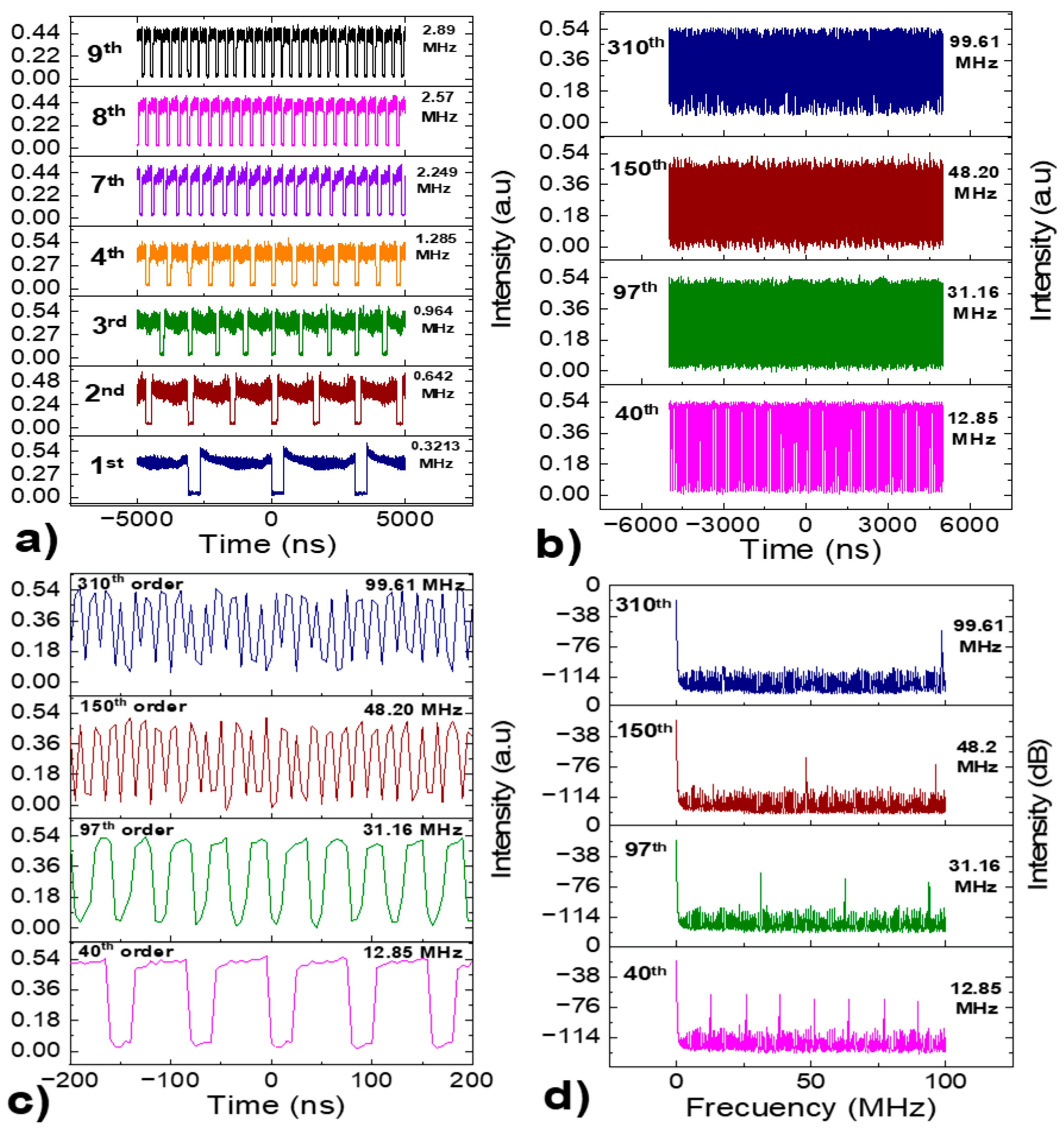
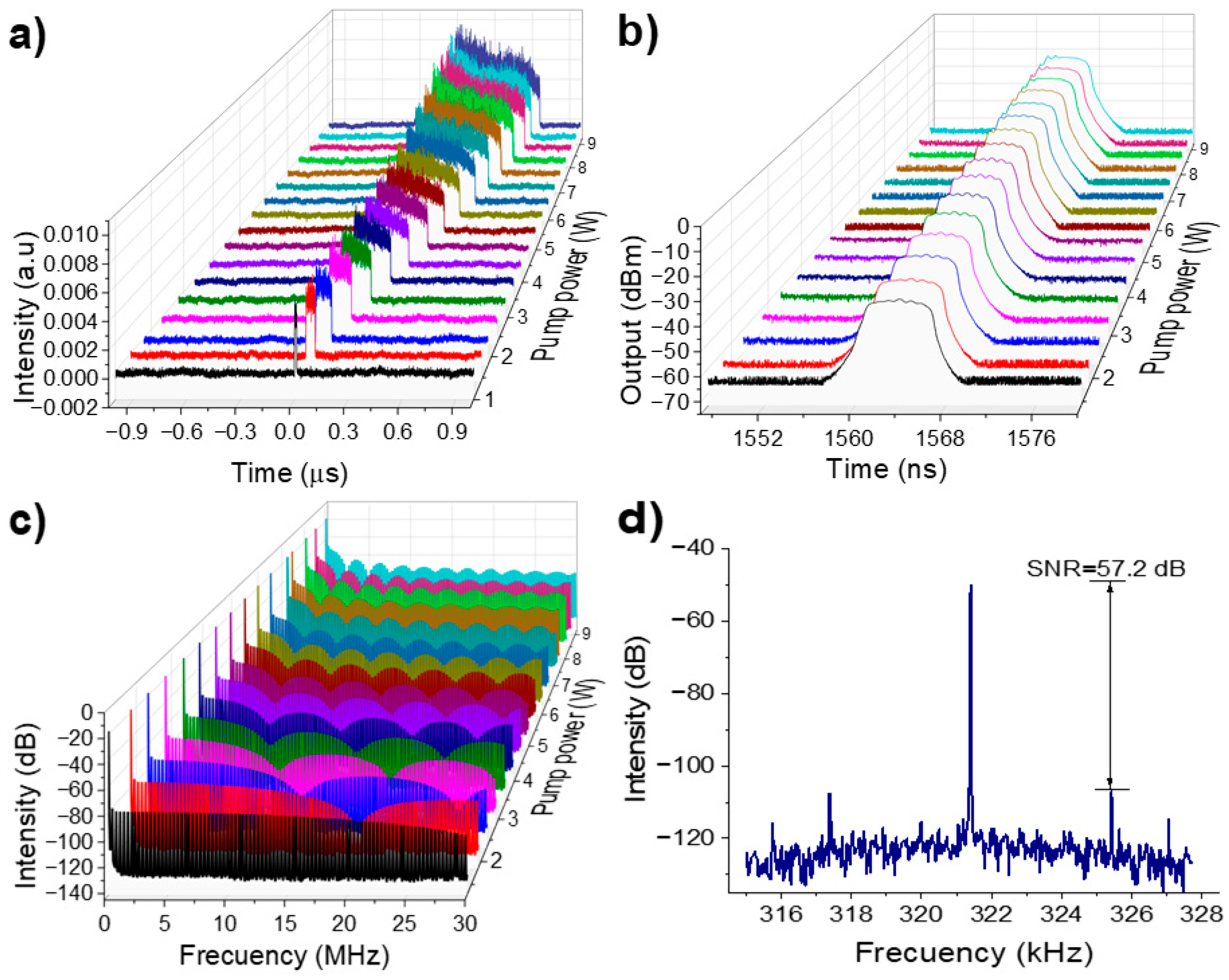
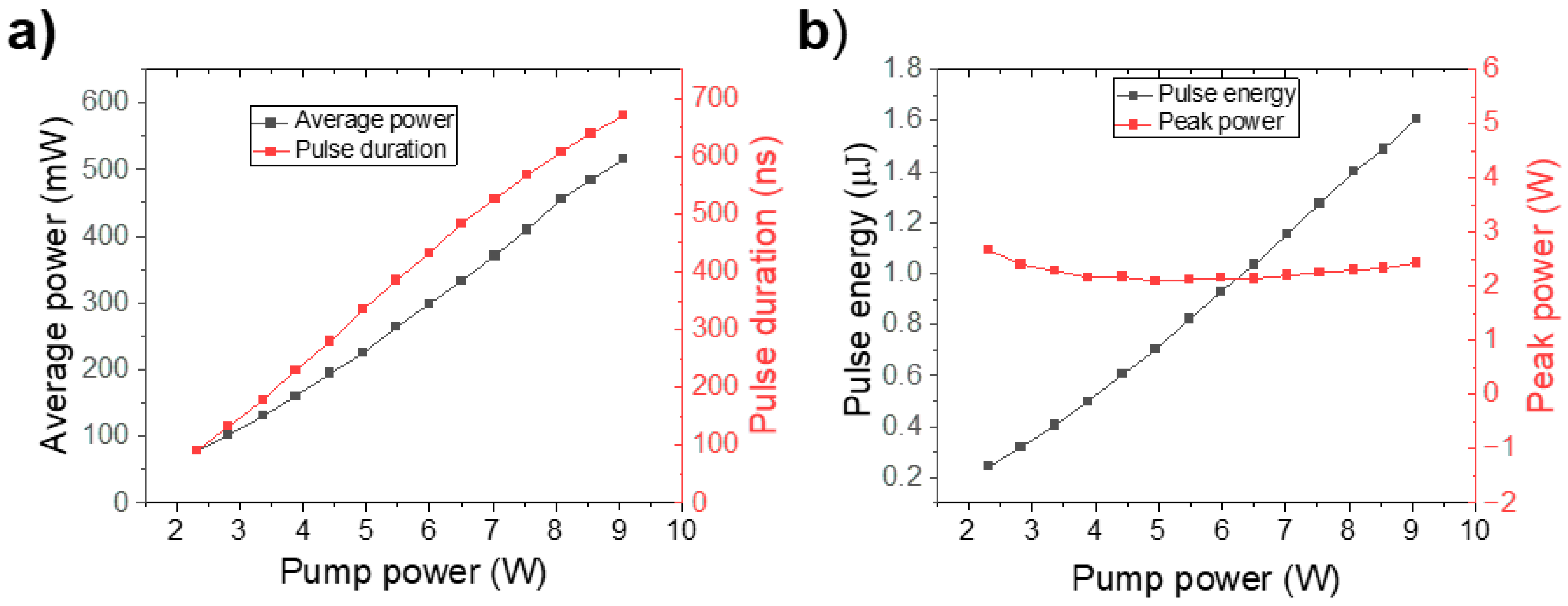
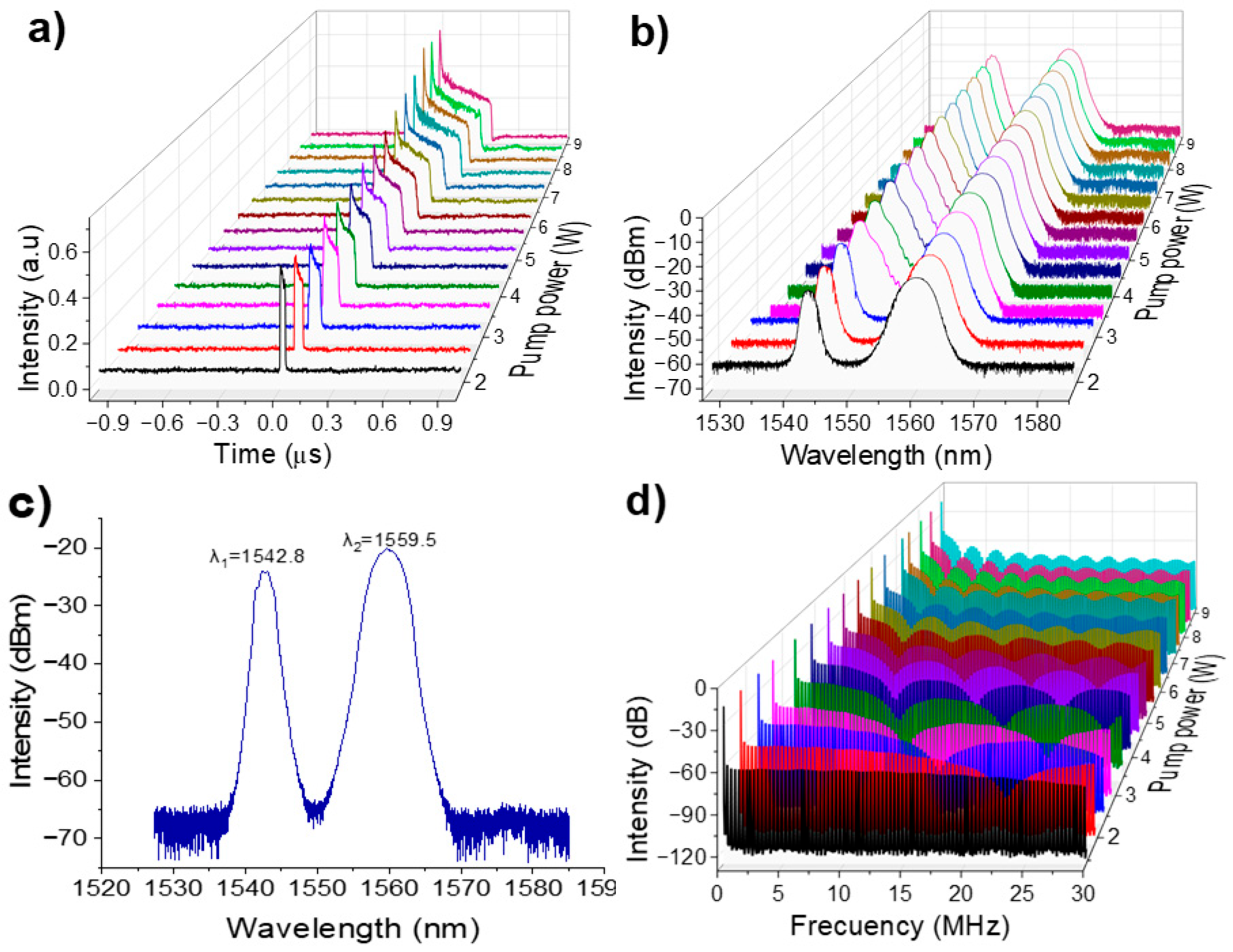

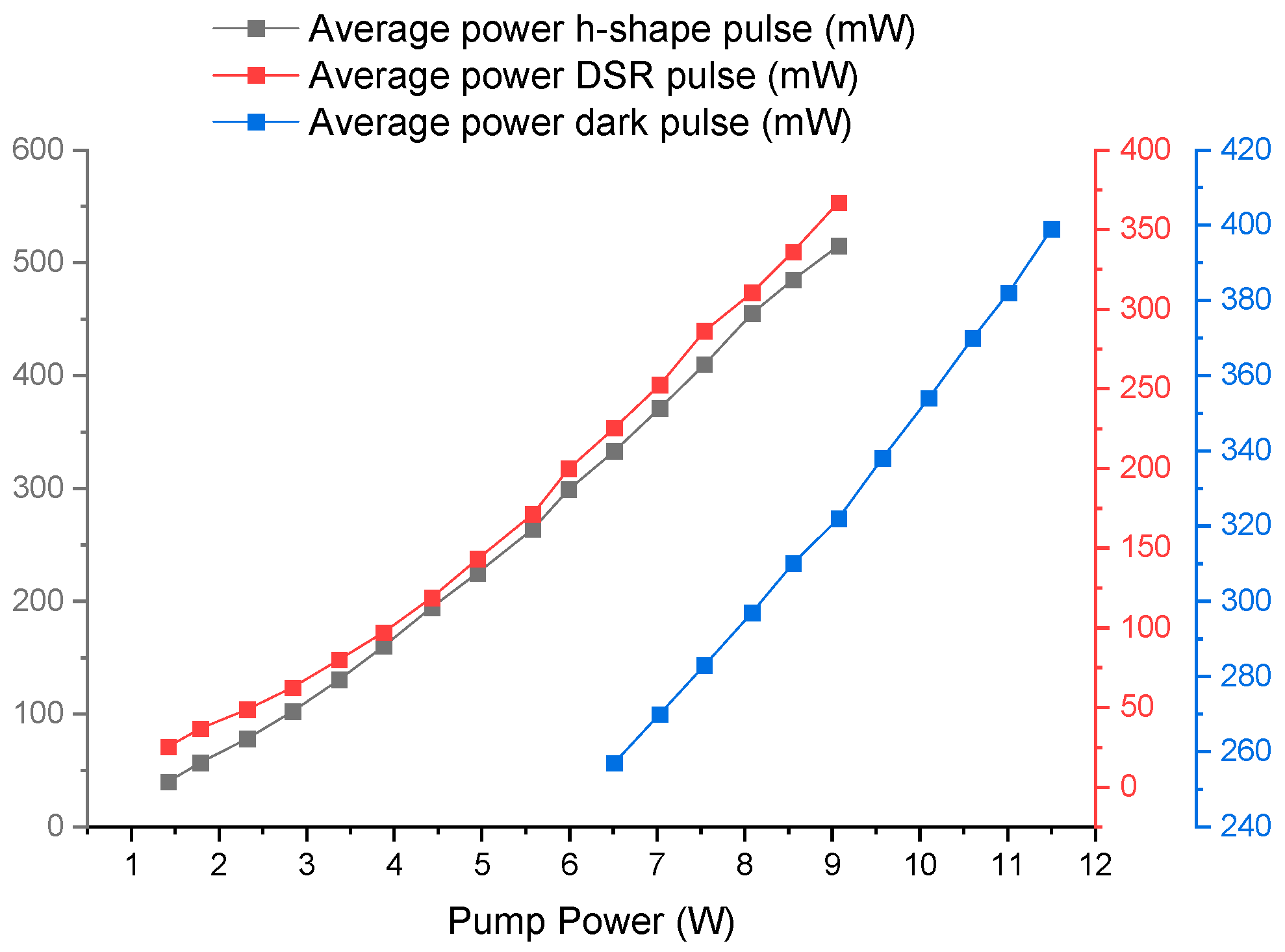
| Cavity Config. | Saturable Absorber | Pump Power (mW) | Repetition Rate (MHz) | Pulse Width (ns) | Output Power (mW) | Pulse Energy (nJ) | Emission Wavelength (nm) | Year | Ref. |
|---|---|---|---|---|---|---|---|---|---|
| Ring | NPR | 260 | 18.18 | 4.5 | 40 | 2.2 | 1588–1591 | 2011 | [16] |
| Ring | Graphene oxide | 200 | 0.41 | 90.8 | 0.858 | - | 1062.5 | 2014 | [6] |
| Ring | MoS2 | 242 | 17.4 | - | 0.80 | 0.046 | 1037, 1039 | 2016 | [23] |
| Ring | NPR | 1100 | 5.854 | 11.8 | - | - | 1880, 1900 | 2017 | [17] |
| Ring | Black P. | 90 | 14.6 | 16.95 | 8.61 | - | 1596, 1599 | 2018 | [21] |
| Ring | Bi2Te3 | 80 | 20.7 | 10.3 | - | - | 1956, 1958 | 2019 | [22] |
| Ring | Glycerin | 33.5 | 23.08 | - | 33.5 | - | 1569.4 | 2019 | [7] |
| Ring | TDF | 120 | 3.03 | 18 | - | - | 1566.75 | 2019 | [19] |
| Ring | TDF | 120 | 2.96 | 100 | 4.14 | 1.4 | 1566.34 | 2019 | [25] |
| Figure 9 | NALM | 225 | 0.323 | 11.8 | 8.8 | 27.2 | 1556, 1563 | 2019 | [27] |
| Linear | NOLM | 362 | 0.203 | 336 | 0.10 | 49 | 1041.5 | 2022 | [13] |
| Ring | MWT | 89 | 5.79 | 25 | 25 | - | 1562, 1563 1564 | 2023 | [8] |
| Ring | TCTDF | 112 | 0.96 | 250 | 6.58 | 3.24 | 1556, 1557, 1558 | 2024 | [26] |
| Ring | SMF-GIME-SMF | 97 | 21.5 | 5 | 16.6 | 769 | 1567.2 1569.4 | 2024 | [18] |
| dumbbell | NOLM-NALM | 6500 | 0.3213 | 560 | 112 | 348 | 1562.5 1563.5 1564.5 | 2025 | This work |
Disclaimer/Publisher’s Note: The statements, opinions and data contained in all publications are solely those of the individual author(s) and contributor(s) and not of MDPI and/or the editor(s). MDPI and/or the editor(s) disclaim responsibility for any injury to people or property resulting from any ideas, methods, instructions or products referred to in the content. |
© 2025 by the authors. Licensee MDPI, Basel, Switzerland. This article is an open access article distributed under the terms and conditions of the Creative Commons Attribution (CC BY) license (https://creativecommons.org/licenses/by/4.0/).
Share and Cite
Reyes-Mora, A.; Durán-Sánchez, M.; Espinosa-De-La-Cruz, E.A.; Alcántara-Bautista, U.; Ibarra-Garrido, A.; Armas-Rivera, I.; Rodríguez-Morales, L.A.; Bello-Jiménez, M.; Ibarra-Escamilla, B. High-Order Domain-Wall Dark Harmonic Pulses and Their Transition to H-Shaped and DSR Pulses in a Dumbbell-Shaped Fiber Laser at 1563 nm. Micromachines 2025, 16, 727. https://doi.org/10.3390/mi16070727
Reyes-Mora A, Durán-Sánchez M, Espinosa-De-La-Cruz EA, Alcántara-Bautista U, Ibarra-Garrido A, Armas-Rivera I, Rodríguez-Morales LA, Bello-Jiménez M, Ibarra-Escamilla B. High-Order Domain-Wall Dark Harmonic Pulses and Their Transition to H-Shaped and DSR Pulses in a Dumbbell-Shaped Fiber Laser at 1563 nm. Micromachines. 2025; 16(7):727. https://doi.org/10.3390/mi16070727
Chicago/Turabian StyleReyes-Mora, Alejandro, Manuel Durán-Sánchez, Edwin Addiel Espinosa-De-La-Cruz, Ulises Alcántara-Bautista, Adalid Ibarra-Garrido, Ivan Armas-Rivera, Luis Alberto Rodríguez-Morales, Miguel Bello-Jiménez, and Baldemar Ibarra-Escamilla. 2025. "High-Order Domain-Wall Dark Harmonic Pulses and Their Transition to H-Shaped and DSR Pulses in a Dumbbell-Shaped Fiber Laser at 1563 nm" Micromachines 16, no. 7: 727. https://doi.org/10.3390/mi16070727
APA StyleReyes-Mora, A., Durán-Sánchez, M., Espinosa-De-La-Cruz, E. A., Alcántara-Bautista, U., Ibarra-Garrido, A., Armas-Rivera, I., Rodríguez-Morales, L. A., Bello-Jiménez, M., & Ibarra-Escamilla, B. (2025). High-Order Domain-Wall Dark Harmonic Pulses and Their Transition to H-Shaped and DSR Pulses in a Dumbbell-Shaped Fiber Laser at 1563 nm. Micromachines, 16(7), 727. https://doi.org/10.3390/mi16070727






